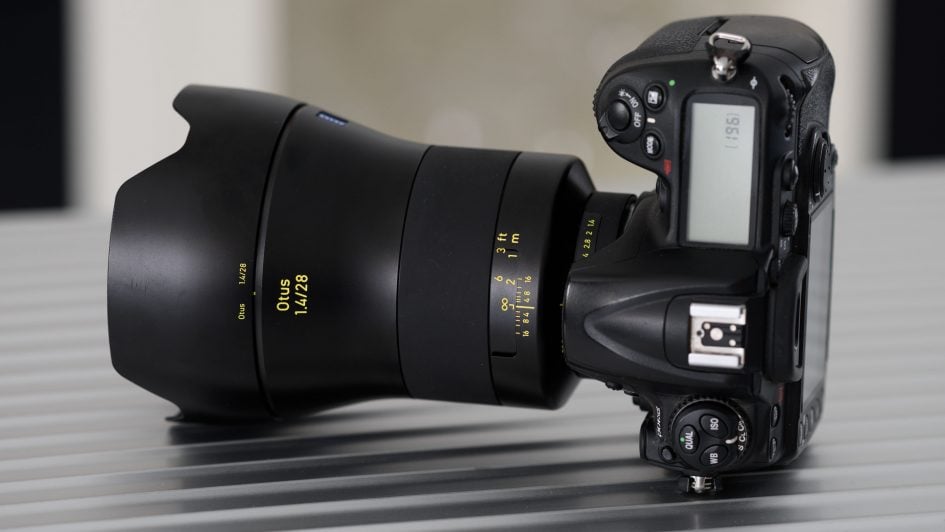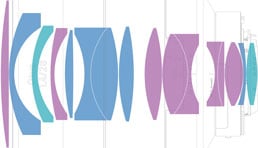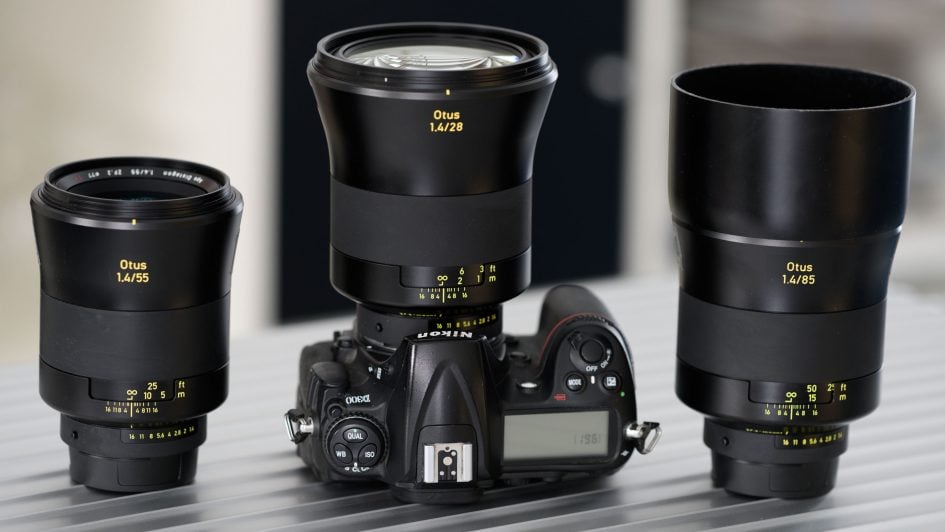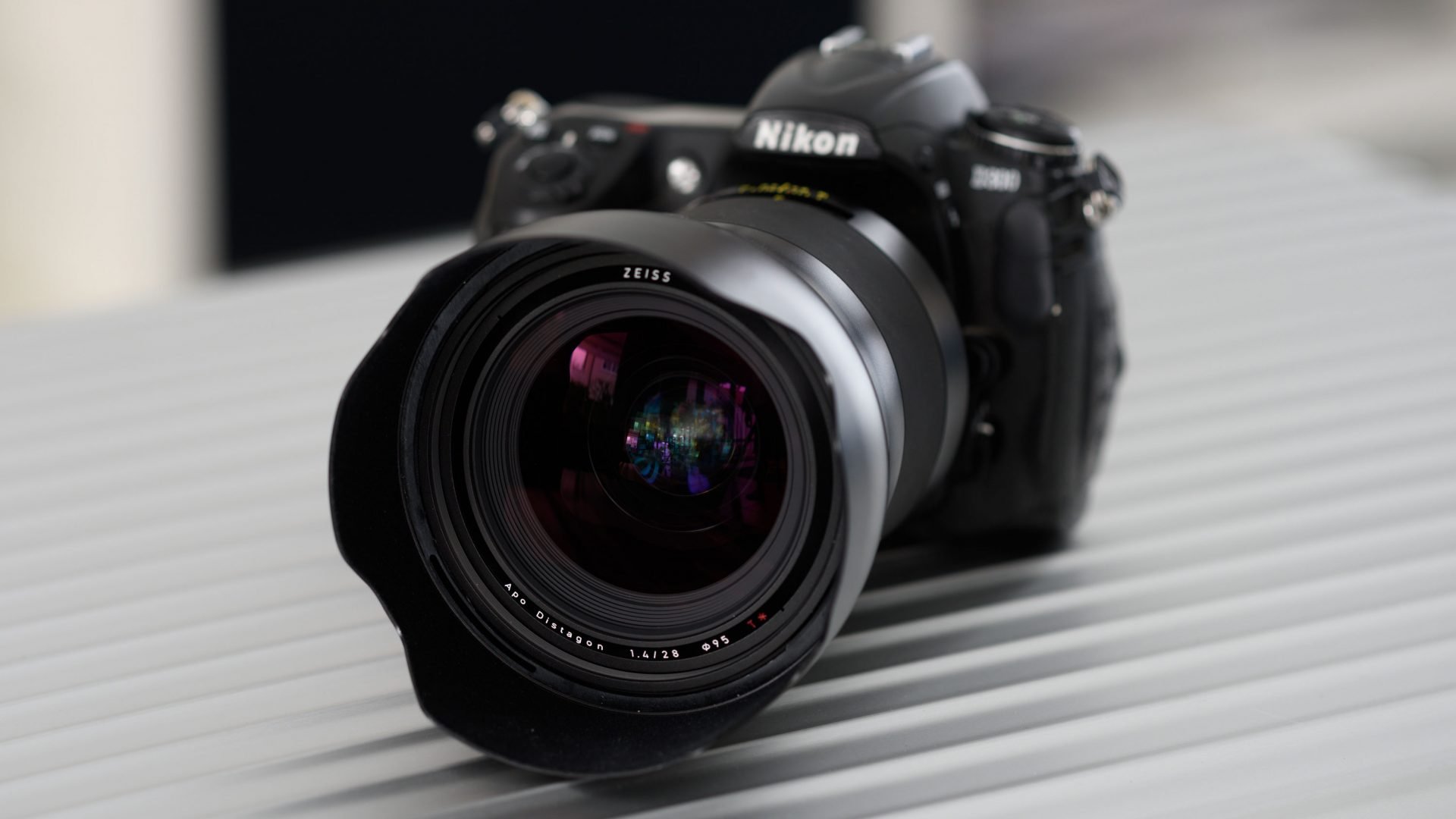Zeiss Otus 28mm f1.4 review
-
-
Written by Thomas
In depth
The Zeiss Otus 28mm f1.4 is a wide-angle lens and the third model in the much acclaimed Otus family. So expectations are very high, matching the incredibly high price tag of 4500 EUR which makes it the most expensive lens of this series so far.
Like its longer siblings the new Otus is available with Canon mount “ZE” and with Nikon F-mount “ZF.2”, but can be used via adapters on other manufacturers’ bodies, such as the Sony A7 / A7r. And like most Zeiss lenses, excluding the Touits and Batis models, it is manual focus only.
The lens is one-of-a-kind as there is no other 28mm f1.4 full-frame lens on the market. But even if you look at 24/1.4 lenses or 35/1.4 lenses none carries this kind of price tag nor describes themselves as being “The world’s best wide-angle lens”. So the questions are: Does this lens continue to redefine what performance level you can get from a modern design and high quality glass? And how much better is this lens than the (near) equivalent offering from e.g. Nikon or Sigma? Can the lens justify a price of 4500 EUR? In my Zeiss 28mm f1.4 review-in-progress I’ll share my findings, including sharpness results, contra-light performance, Bokeh, and a selection of sample images when mounted on a demanding 36MP Nikon D810 body.
PS – don’t forget you can support my work next time you order anything at Amazon, B&H or Adorama by first clicking through to them using the links above and in the sidebar. It works for anything you order at any time – thanks for your support!

Facts from the catalog
As usual I’ll have a look at the technical data first. I’ve rated the features with a [+] (or [++]), when it’s better than average or even state of the art, a [0] if it’s standard or just average, and [-] if there’s a disadvantage. All sizes and weights are from the Nikon version, length is measured from the lens-mount.
Size (diameter x length): 109 x 127 mm. This must be the biggest ever wide-angle lens for full-frame bodies. Although the diameter of the focus ring is about 4mm slimmer than on the 85/1.4 Otus and as such a little easier to grip. The lens-hood adds 35mm to the length of the lens bringing it to a total of 162mm and has a diameter of 118mm. [-]
Weight: 1310g. As in size the lens sets a new record in weight too: It is the heaviest ever wide-angle lens for full-frame bodies. The metal lens hood adds another 62g. The respective f1.4 lenses from Nikon, Sigma and Canon are about half the weight. [-]

Optics: 16 elements in 13 groups. This is a pretty complex design with 26 glass/air-surfaces and 10 special lens elements including two aspheric surfaces. [0]
Closest focus distance is 0.29m which gives you a working distance of around 12 cm when you don’t use the lens-shade. Maximum magnification is 1:5.5. That’s not much but about standard in this lens-class. [0]
Filter-thread: 95mm. Even bigger and more expensive than the 86mm filter-thread of the 85/1.4 Otus. All 24/1.4 lenses use 77 mm filters – which is the size that most pro-lenses use. So expect to invest heavily into new filters with the new lens. [-]
Image stabilization: No f1.4 prime lens offers optical stabilization. And with the small magnification at a focal length of 28mm it is no big loss. Still: shooting dim interiors or landscapes in fading light hand-held can prove quite a challenge without stabilization. [0]
Auto focus: No! Manual-focus only. [-]
Coverage: covers full frame/FX or smaller = very good. [+]
Price: around 4500 EUR new (incl. 19% VAT). The f1.4 wide-angle 24mm primes from Nikon or Canon cost around a third, the one from Sigma only a sixth. And those all offer autofocus. [-]
Comes with no lens pouch but a metal lens hood is included, reversible for transport, and the lens caps are similar to Nikon’s. [-]
Distance information is not relayed to the camera, the lens delivers a value of 0.01m regardless of the distance you choose. This disables some of the advanced exposure-related stuff e.g. a Nikon body can do although the lens does have electrical contacts and communicates some EXIF data with the body. All the competing autofocus lenses from Sigma, Nikon and Canon relay subject-to-camera-distance. [0]
Aperture ring: yes (Nikon ZF.2 version only), so you can control aperture from the lens just like in old times. [+]
Sealing: no rubber-grommet at the lens-mount. I asked Zeiss about their lens being “hardened” for the elements. They replied that the enclosure of the optical groups effectively seals the lens against dust and moisture. But still: without a seal between the lens and the body there is the risk of moisture getting in there. [0]
The score in the “features-department” is 6[-]/5[0]/2[+]. The new Otus is much larger and heavier than the competition, has no AF, no lens-pouch, no electronic distance information, and an exorbitant asking price. On paper it looks even worse than the 55/1.4 Otus, the extra minus being the 95mm filter-thread. So only an extraordinary optical performance will make this lens interesting to anybody.

Above left: Zeiss Otus 55mm f1.4, middle: Zeiss Otus 28mm f1.4, right: Zeiss Otus 85mm f1.4
If you want to read up on the other members of the Otus family, head over here: My Zeiss Otus 55/1.4 review or my Zeiss Otus 85/1.4 review.
Alternatives
As there is no other 28mm f1.4 lens you have to make some compromise if you’re looking for alternatives:
– For owners of Nikon DSLRs there is the 28mm f1.8G ED which is much, much smaller (73 x 81 mm), lighter (330 g), and cheaper (550 EUR) than the Otus. See my Nikon 28/1.8G review where it earned a recommendation. Then there are the pro-grade AF-S Nikkor 24mm f1.4G ED (1750 EUR, see my Nikon 24/1.4G review) and the Nikon 35mm f1.4G ED (1500 EUR, see my Nikon 35/1.4G review). A 24mm prime offers a 14% wider view than a 28mm lens which you can easily compensate for by cropping – if you’re willing to give up 26% of the pixels. With a 35mm lens things might not be so easy as it has a crop-factor of 1.25x built in compared to a 28mm lens. So you need to step back a quarter of your subject -distance (and change the perspective accordingly) to capture the same frame or you lose parts of the image.
– Sigma offers the 24mm f1.4 DG HSM Art and the 35mm f1.4 DG HSM Art lenses which both earned a Highly Recommended (see my Sigma 24/1.4 Art review and Sigma 35/1.4 Art review). They are not the smallest or lightest wide-angle primes but they are clearly dwarfed by the Otus and even buying them both would only set you back one third of the price of the Zeiss lens. My remarks regarding the viability of a 24mm or 35mm prime replacing a 28mm prime from above apply as well.
– From Canon there is the EF 28/1.8 USM which is small, lightweight and costs below 500 EUR. Plus Canon offers pro-grade f1.4 “L” lenses at 24mm and 35mm. Their latest “II” versions set you back around 1300 EUR resp. 1900 EUR.
– Zeiss itself offers the 28mm f2.0 Distagon for 1100 EUR which is a much simpler 10 elements/8 groups design – and manual focus, too. If you’re a Sony mirrorless shooter, there’s also the Zeiss Batis 25mm f2, which features AF.
You may also consider full-frame zooms albeit none has a larger than f2.0 aperture. But some have image stabilization which lets you shoot in light that is as low or even lower than with the Otus:
– The Tamron SP AF 15-30mm 2.8 Di VC USD (around 1000 EUR). It earned a Highly Recommended in my Tamron 15-30/2.8 VC review. It reaches an incredibly wide 15mm on the short end and its stabilization is good for at least 2 stops.
– Nikon’s new AF-S VR 24-70mm 2.8E ED is the most expensive alternative at 2400 EUR . It reaches 2.5x further with its 70mm focal length at the long end and has a very effective image stabilization good for at least 3 stops. See my Nikon 24-70/2.8E VR review.
– From Sigma there’s the 24-35/2.0 DG HSM Art. It’s not stabilized but its bright f2.0 focal ratio compensates a bit for that. In my Sigma 24-35/2.0 Art review it earned a Highly Recommended and costs around 950 EUR.
Focus
As with the 55/1.4 Otus I can only say: if you can’t manage to properly focus manually you better forget about this lens, skip this review to avoid being infected by the superior image quality, and head over to alternative normal lenses that offer autofocus. But if your shooting style allows for taking a second or third shot to nail focus properly then chances are that the Zeiss Otus is one of the most accommodating lenses for the intricacies of manual focus. And to be honest: Even with all the autofocus lenses I use I almost always check for perfect focus, because with less than ideal targets there’s always a chance the camera pulled focus to a different spot than you intended it to.
The focus ring has no slack/play between its movement and the focus-action and a throw of 120 degrees, which is ideal for accurate focus wide open. The focus ring is easy to grip even with gloves although it has no structure. It moves very smoothly and can be operated with one finger. It has hard stops on both sides of the distance scale so you know exactly when you’ve reached one or the other end of the focus range. But the hard stop on the far end is a bit beyond infinity so you star-gazing photogs still need to find exact focus manually if you want to capture the Milky Way in all its sparkling glory.
Build quality
The lens has nine rounded aperture blades and the aperture ring has half-stop clicks up to f11, although there’s no smooth step-less option that videographers would have liked. To operate the aperture from the camera simply set it to f16 where it is automatically arrested with a small latch/button. The lens is built like a tank with a fully metal outer barrel, metal innards, and a metal lens hood that fits seamlessly at the lens-front and does not rattle. This full-metal build is frowned upon by some fearing problems at sub-zero temperatures. But I tested the 55/1.4 Otus coming from a night in the deep-freezer and neither did my naked fingers stick to the cold metal surface nor did the focus-action become too stiff. Operating the lens at -22 degrees Celsius (-8 degrees Fahrenheit) was no problem at all and I expect the 28/1.4 being no different in this regard.
The design is gently curved even with the lens hood attached and the surfaces are all smooth and easy to clean except for the rubber focus ring. All-in-all holding and operating this lens conveys a feeling of great craftsmanship and solid high-quality build that is in-line with the other two Otuses and exceeds any other lenses I’ve ever touched.

 Optical performance plus build quality: The Zeiss 28mm f1.4 Otus delivers sharpness, contrast, resistance against contra light, coma, loCA, purple fringing, Bokeh on a very high to exceptional level even at f1.4 and puts this in a package that exudes quality in every aspect of its physical presence. This is really the lens that you can use wide open with little to no compromise in optical performance and in that it is the best wide-angle lens I've tested. But you have to focus manually. So I'd say: This is not a lens for everybody - even if you forget (if you can) the steep price. You should clearly understand what this lens can and cannot do for you before considering getting one. With regard to the price: yes, the Otus is clearly an expensive lens, but take a look at Leica's lenses and you understand that top-notch optical performance has its price. Compared to Leica Summilux-M f1.4 ASPH lenses the Zeiss Otus looks fairly priced. Summing it all up I think the Zeiss 28mm f1.4 Otus has well earned a Highly Recommended.
Optical performance plus build quality: The Zeiss 28mm f1.4 Otus delivers sharpness, contrast, resistance against contra light, coma, loCA, purple fringing, Bokeh on a very high to exceptional level even at f1.4 and puts this in a package that exudes quality in every aspect of its physical presence. This is really the lens that you can use wide open with little to no compromise in optical performance and in that it is the best wide-angle lens I've tested. But you have to focus manually. So I'd say: This is not a lens for everybody - even if you forget (if you can) the steep price. You should clearly understand what this lens can and cannot do for you before considering getting one. With regard to the price: yes, the Otus is clearly an expensive lens, but take a look at Leica's lenses and you understand that top-notch optical performance has its price. Compared to Leica Summilux-M f1.4 ASPH lenses the Zeiss Otus looks fairly priced. Summing it all up I think the Zeiss 28mm f1.4 Otus has well earned a Highly Recommended.



